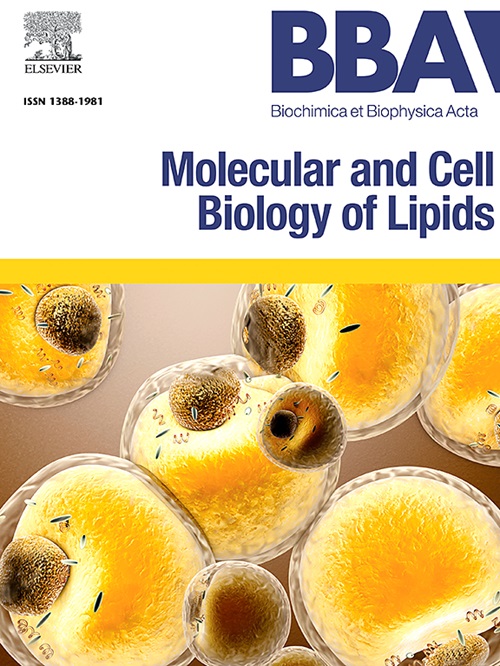Eicosapentaenoic acid inhibits cholesterol efflux pathways from cholesterol-loaded human THP-1 macrophages by reducing the hydrolysis of cholesteryl esters mediated by carboxylesterase 1
IF 3.3
2区 生物学
Q2 BIOCHEMISTRY & MOLECULAR BIOLOGY
Biochimica et biophysica acta. Molecular and cell biology of lipids
Pub Date : 2025-06-13
DOI:10.1016/j.bbalip.2025.159646
引用次数: 0
Abstract
A diet high in n-3 polyunsaturated fatty acids (PUFAs), particularly eicosapentaenoic acid (EPA) (C20:5 n-3), is cardioprotective. PUFAs integrate into membrane phospholipids, altering membrane protein function. We investigated the effects of various PUFAs on the anti-atherogenic cholesterol efflux pathways from cholesterol-loaded human THP-1 macrophages. Cells were supplemented (or not: standard cells) with 70 μM EPA, 50 μM arachidonic acid (AA) (C20:4 n-6) or 15 μM docosahexaenoic acid (DHA) (C22:6 n-3) for an extended duration to simulate a dietary strategy. EPA led to a 13 % decrease in ABCA1-mediated cholesterol efflux and to a 17 % decrease in SR-BI/ABCG1-mediated cholesterol efflux without affecting the expression of efflux proteins, while AA and DHA showed no impact. Compared to standard cells, EPA cells exhibited higher EPA levels along with reduced AA levels. EPA cells showed increased amounts of triglycerides and cholesteryl esters (CE) without a change in the acetylated LDL uptake. EPA did not influence the phenotype of macrophages according to surface markers and released cytokines. The incorporation of EPA did not disrupt efflux in macrophages loaded with free cholesterol. Conversely, EPA decreased CE hydrolysis from lipid droplets by 22 %. The diminished cholesterol efflux was not related to triglyceride accumulation or to variations in apo E secretion. EPA reduced the expression of carboxylesterase 1 (CES1) protein by 17 % without affecting the expression of neutral cholesterol ester hydrolase 1 (NCEH1). In conclusion, the membrane incorporation of EPA hinders the cholesterol efflux pathways in THP-1 foam cells likely by impairing the CE hydrolysis mediated by carboxylesterase 1.
二十碳五烯酸通过减少羧酸酯酶1介导的胆固醇酯水解来抑制胆固醇负荷的人THP-1巨噬细胞的胆固醇外排途径。
富含n-3多不饱和脂肪酸(PUFAs)的饮食,特别是二十碳五烯酸(EPA) (C20:5 n-3),对心脏有保护作用。PUFAs整合到膜磷脂中,改变膜蛋白功能。我们研究了各种PUFAs对胆固醇负载的人THP-1巨噬细胞抗动脉粥样硬化胆固醇外排途径的影响。细胞被添加(或不添加:标准细胞)70 μM EPA、50 μM花生四烯酸(AA) (C20:4 n-6)或15 μM二十二碳六烯酸(DHA) (C22:6 n-3)较长时间,以模拟饮食策略。EPA导致abca1介导的胆固醇外排减少13 %,SR-BI/ abcg1介导的胆固醇外排减少17 %,而不影响外排蛋白的表达,而AA和DHA没有影响。与标准细胞相比,EPA细胞表现出较高的EPA水平和较低的AA水平。EPA细胞显示甘油三酯和胆固醇酯(CE)的数量增加,但乙酰化LDL的摄取没有变化。根据表面标记物和释放的细胞因子,EPA对巨噬细胞的表型没有影响。EPA的掺入不会破坏装载游离胆固醇的巨噬细胞的外排。相反,EPA使脂滴的CE水解降低了22% %。胆固醇外排减少与甘油三酯积累或载脂蛋白E分泌变化无关。EPA使羧酸酯酶1 (CES1)蛋白的表达降低了17. %,但不影响中性胆固醇酯水解酶1 (NCEH1)的表达。综上所述,EPA的膜掺入可能通过损害羧酸酯酶1介导的CE水解来阻碍THP-1泡沫细胞中的胆固醇外排途径。
本文章由计算机程序翻译,如有差异,请以英文原文为准。
求助全文
约1分钟内获得全文
求助全文
来源期刊
CiteScore
11.00
自引率
2.10%
发文量
109
审稿时长
53 days
期刊介绍:
BBA Molecular and Cell Biology of Lipids publishes papers on original research dealing with novel aspects of molecular genetics related to the lipidome, the biosynthesis of lipids, the role of lipids in cells and whole organisms, the regulation of lipid metabolism and function, and lipidomics in all organisms. Manuscripts should significantly advance the understanding of the molecular mechanisms underlying biological processes in which lipids are involved. Papers detailing novel methodology must report significant biochemical, molecular, or functional insight in the area of lipids.

 求助内容:
求助内容: 应助结果提醒方式:
应助结果提醒方式:


